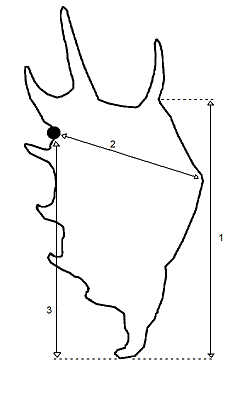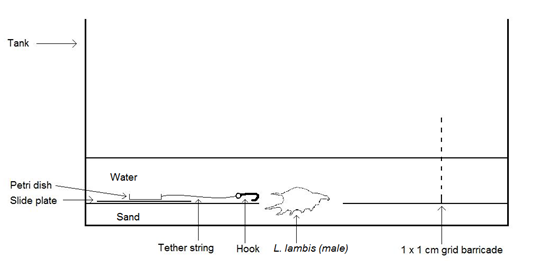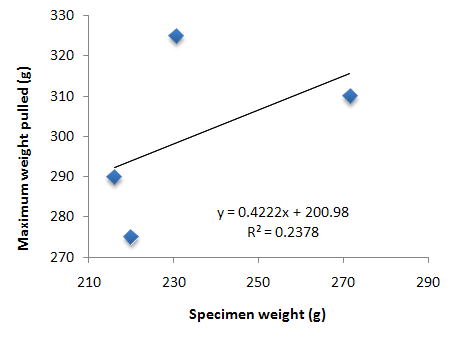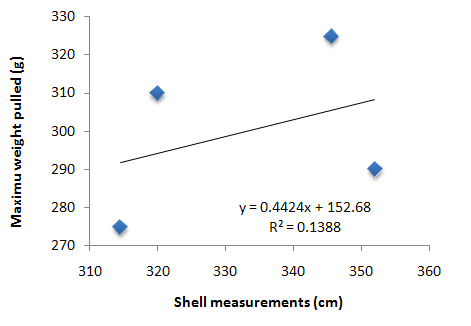Analysing the strength of the spider conch (Lambis lambis) during locomotion
Introduction
The spider conch (Lambis lambis) is species of marine gastropod in the family Strombidae (Poultiers 1998). This species is widely distributed throughout the Indo-West Pacific, living in reef flat zones and mangrove areas to depths of 5 m (Walls 1980). Their large, robust shells can reach 29 cm in length and weigh up to 400 g (Berg 1973). They graze on macroalgae and detrital films and therefore play a significant role in their food chains (Walls 1980).
An interesting and unique characteristic of all strombids is their mean of locomotion (Parker 1922). Most gastropods glide slowly across a substrate by passing muscular waves over the foot, whereas strombids propel themselves forward in a rapid leaping motion using their foot and modified pointed operculum (Berg 1973). The coordination of a high level of strength and accurate technique is necessary to propel their heavy shells (Berg 1973).
Since the mid 1800’s, many studies have investigated the leaping behaviour of strombids in great detail (Adams 1848; Colton 1905; Crozier 1919; Parker 1922; Kohn 1965; Berg 1973). However, very little is known about the actual strength of these organisms during locomotion. The aim of this study is to investigate the maximum force output of male spider conches during locomotion, and investigate the relationship between specimen size and strength. It is hypothesised that specimen strength will increase with specimen size.
Methods
Sample collection
From 19 September to 23 September 2011, a total of 5 spider conchs (4 males and 1 female) were collected from the Heron Island reef flat zone and experimentally examined. Dry weights and shell measurements were recorded and displayed in Table 1. For details on shell measurements see Figure 2.
Table 1: Dry weights and shell measurements of the 5 spider conch specimens used in this experiment.
Specimen
|
Dry weight (g)
|
Shell measurements (cm)
|
| 1 |
230.5 |
345.5 |
| 2 |
216.1 |
352 |
| 3 |
271.5 |
320 |
| 4 |
220 |
314.5 |
5 (Female)
|
68.3 |
222.5 |

Figure 2: The three shell measurement
taken to represent shell size
|
Experiment tank
Experiments were conducted in a 140 x 80 cm tank, which was filled with an 8 cm layer of sand, and a further 15 cm of sea water (see Figure 3). A 30 x 21 cm acrylic slide plate was positioned at one end of the tank and secured on the substrate using dive weights. A Petri dish was positioned in the centre of this plate to be filled with various weight increments. One end of a tether string was attached to this dish, and the other end was attached to a hook. This hook was attached to attachment points (washers) on L. lambis specimens. These washers were fitted to specimens by tying bricklayer’s string around the three posterior marginal digitations in such a way that leaping motions were not impeded.

Figure 3: Schematic diagram of the experimental tank set up. |
The results of preliminary observations revealed that male spider conchs were strongly attracted to a female when placed in the same tank. This finding inspired the use of a female as a male attractant during experiments. A 1 x 1 cm grid barricade was positioned at the other end of the tank to keep the female spider conch in position during experiments.
Challenges
Specimens were challenged to pull various weight increments, starting at 250 g and increasing 5 g with successive passes. A pass was awarded when the weight containing petri dish was dragged more than 5 cm from its original position, within in 10 or less attempts or “leaps”. Specimens were rested for at least 10 minutes between repetitions to reduce the effects of fatigue. When a specimen failed a particular weight, it was rested for at least 10 minutes before being re-challenged at the same weight. This was to insure the accuracy of failure weight.
Data analysis
A regression was used to determine the relationship between specimen size and specimen strength.
Results
Specimen strength was found to increase with specimen weight (Figure 4). However, this correlation was not very strong (R ² = 0.237). All four specimens successfully pulled weights greater than their body weights, with an average weight difference of +28.6%. Specimen strength was also found to increase with increasing shell sizes (Figure 5). Again, this correlation was not very strong (R ² = 0.139).

Figure 4: The relationship between specimen weight and maximum challenge weight successfully pulled by four male spider conch specimens. While the slope of the relationship is positive, it does not accurately represent the data (R² = 0.237).
|

Figure 5: The relationship between specimen shell size and maximum challenge weight successfully pulled by four male spider conch specimens. While the slope
of the relationship is positive, it does not accurately represent the data (R² = 0.129).
|
Discussion
While not tightly correlated, specimen weight generally increased with specimen shell size. For this reason, specimen shell size and specimen weight are suitable measurements for representing overall specimen size. This study was also the first to record the maximum strengths of spider conchs during locomotion, which were measurements of maximum weight pulled. All four specimens successfully pulled weights greater than their body weight. Specimen 1 set the highest weight pulled at 325 g, with its dry weight being 230.5 g.
The results of this study indicate that spider conch strength increases with spider conch size. This is likely explained by larger specimens having more muscle mass, and therefore the potential to pull heavier weights (Berg 1973).
Due to the scarcity of spider conchs on Heron Island, only five specimens were collected during sampling. It is suggested that future studies aim to collect more specimens, which will greatly improve the accuracy, and increase the strength of the results.
There are extensive amounts of literature investigating the locomotion of strombids (Adams 1848; Colton 1905; Crozier 1919; Parker 1922; Kohn 1965; Berg 1973). This study has contributed to this knowledge by successfully determining the strength of male spider conchs during locomotion.
References
Adams, A 1848, ‘Notes on the natural history of islands’, Belcher, vol. 2, pp. 223-532.
Berg, CJ 1973, ‘A comparative study of strombid gastropods’, Behaviour, vol. 51, pp. 274-332.
Crozier, WJ 1919, ‘On the use of the foot in some molluscs’, Journal of Experimental Zoology, vol. 27, pp. 359-366.
Colton, HS 1905, ‘Some notes on living Strombis pugilis’, Nautilus, vol. 19, pp. 85-88.
Kohn, AJ 1965, ‘Locomotion of the herbivorous gastropod Strombus canarium, and its escape response to a predatory gastropod’, American Zoology, vol. 5, no. 4, 632-633.
Parker, GH 1922, ‘The leaping of the stromb (Strombus gigas Linn.)’, Journal of Experimental Zoology, vol. 36, no. 2, pp. 205-209.
Poultiers, JM 1998, ‘Seaweeds, corals, bivalves and gastropods’, The living marine resources of the Western Central Pacific, vol. 1, pp. 467.
Walls, JG 1980, Conchs, Tibias, and Harps, T.F.H., Worldwide.
World Register of Marine Species 2011, Lambis lambis (Linnaeus, 1758), viewed 24 October 2011, http://www.marinespecies.org/aphia.php?p=taxdetails&id=211096 |